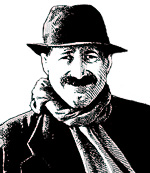>> Top Nine: Yusuf's Choice
>> Alphabetti Fumetti: S is for Shooter
More...

 B is for Berger, Karen
B is for Berger, Karen
b. ?
Vertigo's long-serving lead editor, Karen Berger didn't grow up reading comics like most of her colleagues - nothing except for the occasional issue of MAD or NATIONAL LAMPOON - and was never constrained in her ideas of the kind of stories that comics could be used to tell. Berger has bought a mature and adult perspective to a mainstream publisher, and she has carved out a niche where diverse and adventurous titles continue to be published. Not for nothing is the Vertigo imprint sometimes referred to as the 'Bergerverse'.
Berger started out doing 'girly' comics like AMETHYST and WONDER WOMAN, but soon developed a skill for editing horror comics that were slightly askew from the usual parade of long johns - stuff like HOUSE OF MYSTERY and SWAMP THING. Gradually her stable grew to encompass HELLBLAZER, ANIMAL MAN, SANDMAN, SHADE and DOOM PATROL, and in 1993 these titles were organised into a 'mature readers' line called Vertigo.
This first generation of popular titles have since given birth to a second - PREACHER, THE INVISIBLES, TRANSMETROPOLITAN and BOOKS OF MAGIC - and a third - FABLES, THE LOSERS, Y THE LAST MAN, and 100 BULLETS. These books encompass more than one genre, and they have an appeal that reaches far beyond the traditional fanboy demographic.
Berger's name is not as well known as some of the people she's worked with, but she deserves recognition for the way in which she has helped many talented people to realise their creative vision. Where other editors might have trembled at the concepts these creators presented, she saw their potential and backed them to the hilt. The industry doesn't just need more women; it needs more women like Karen Berger.
 B is for Bolland, Brian
B is for Bolland, Brian
b. 1950; Lincolnshire, England
1978: 'Judge Dredd'; 1982: CAMELOT 3000; 1988: THE KILLING JOKE; 2005: BOLLAND STRIPS
Every so often, an artist will draw a character in so definitive a style that they become forever associated with one another. Brian Bolland has done it twice, first with Judge Dredd, and then with Batman's arch-nemesis the Joker. Perhaps the reason for his success with both characters is that they play to his strengths as an artist; on the one hand there is the crosshatched rigidity of the lawman of the future, on the other there is the spiky black humour of the criminally insane 'clown prince of crime'.
Bolland came to prominence drawing Judge Dredd in the weekly British science fiction anthology 2000AD. These were the early days of the strip's development, and together with fellow artist Mike McMahon he defined the character and the world he inhabited.
Their Dredd was a sneering, wire-thin shit-kicker in skin-tight black leather; if he wasn't busy upholding the law in Mega-City One, he would've looked right at home on the streets of London during the seventies punk explosion. Bolland further left his mark with the introduction of characters like Psi-Judge Anderson and a supernatural inversion of Dredd called Judge Death. It wasn't long before America came calling, however, and Bolland crossed the pond to work for DC as part of the "British Invasion".
His first major assignment was the 12-part maxi series CAMELOT 3000, with writer Mike W Barr, which posited the legend of King Arthur in the distant future. The series was marginally popular, and Bolland was later paired with Alan Moore to work on THE KILLING JOKE, a graphic novel that related a 'probable' version of the Joker's origin. This distinctly adult tale is famous for, amongst other things, depicting the crippling of Commissioner Gordon's daughter, Barbara, by the Joker's hand.
Although Moore has often stated that it is a prime example of weak storytelling on his part, it still remains a landmark work by Bolland. It is dark and provocative, not least in the sequence where the Joker attempts to drive Commissioner Gordon mad by showing him pictures of Barbara being tortured. The scenes of swirling pandemonium presided over by a gurning Joker are the stuff of nightmares, made all the more unsettling when contrasted with the poor misguided innocent he is shown to be in a previous life.
Since those great heights, Bolland has done very little in the way of regular pencilling duties. He has confined himself to drawing highly detailed cover art for major DC publications like WONDER WOMAN, ANIMAL MAN, THE INVISIBLES and THE FLASH. Far from resting on his laurels, Bolland has continued to develop his technique by switching from conventional hand-drawn art to drawing on a digital palette; consequently, any pre-digital original artwork that you can buy now is likely to soar in value in the future.
 B is for Byrne, John
B is for Byrne, John
b. 1950; West Bromwich, England
1977: UNCANNY X-MEN; 1979: FANTASTIC FOUR; 1983: ALPHA FLIGHT; 1986: MAN OF STEEL; 1992: JOHN BYRNE'S NEXT MEN
My one abiding memory of John Byrne is from the mid-80s, when he was at the height of his popularity. Byrne was the cover feature for comics magazine MARVEL AGE, spoofing the artwork to FANTASTIC FOUR #1 by drawing himself as the jocular substitute for the monster who originally bedevilled Marvel's first family. Inside were more pleasantries, with a lengthy interview accompanied by a self-portrait of Byrne at the drawing board, surrounded by Marvel's pantheon of heroes. Everyone in that drawing was smiling, not least Byrne himself, because he had plenty to smile about. He was on top of the world, and everyone thought the sun shone out of his arse.
Fast forward to the present, and we have an altogether different picture. Byrne's reputation is at an all-time low, with his book sales failing to approach their former heights and most of his titles cancelled within two years, while Byrne himself has assumed the character of a cantankerous old fart, issuing screeds against fellow professionals, the industry, and anything else that gets his goat.
Of course, no-one is expected to remain at the top of their game after nearly 40 years in the business, but Byrne's vindictiveness in the face of changing trends and readers' habits has made his transition from the cutting edge to museum piece something of a prolonged tragicomedy.
Byrne puts us in a bit of a quandary, therefore. Namely, how to separate the man from the artist? There is absolutely no doubt that he is a great talent who has helped produce some of the most dynamic and exciting comics ever published in the mainstream. Byrne's drawing style is instantly recognisable, often with large panels of granite-jawed titans engaged in epic battles. Visually, Byrne treads a fine line between realism and bombast - a perfect match for the superhero soap operas he specialises in.
His collaboration with Chris Claremont on UNCANNY X-MEN is the single strongest reason why that merry band of mutants remains popular today. The stories he created on FANTASTIC FOUR are second only to the Lee/Kirby era that inaugurated the Marvel age of comics. After years of stagnation and growing indifference, his reboot of SUPERMAN breathed new life into comicdom's flagship character. For all of this, and more, we are grateful to John Byrne.
The trouble with success, however, is that sometimes your ego grows to monstrous proportions. Byrne does not respond well to criticism, and has often fallen out with both his contemporaries and his readers. He is also very possessive of those characters he has worked on, repeatedly ignoring continuity previously laid down by others.
The disastrous relaunch of the Spider-Man line is one example, where the origin of Peter Parker's powers were intertwined with Doctor Octopus; a more recent occurrence was his re-launch of DOOM PATROL for DC, completely disregarding the history established by Grant Morrison in the 90s. This tendency to dismantle anything that does not correspond to his own personal vision appears symptomatic of a basic lack of respect for his fellow professionals, despite his protestations to the contrary.
Nowadays, Byrne devotes much of his time to resurrecting minor characters created by Jack Kirby (whom he worships) and crafting 'alternative' histories for his favourite heroes. Byrne prides himself on his prolific output, but much of his recent work has been mediocre.
It's hard to believe that is the same man who made comics so exhilarating in the late 70s and early 80s. The safest thing to do is to just ignore the existence of anything he created after 1992, in much the same way that all Michael Jackson albums after THRILLER should be disregarded.

This article is Ideological Freeware. The author grants permission for its reproduction and redistribution by private individuals on condition that the author and source of the article are clearly shown, no charge is made, and the whole article is reproduced intact, including this notice.


